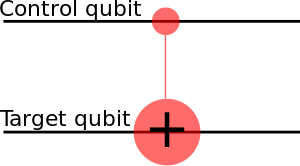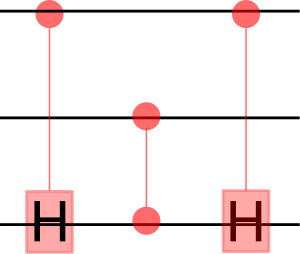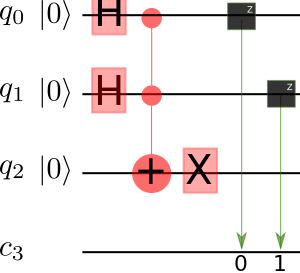Qiskit
Introduction
https://quantum-computing.ibm.com/
https://quantum-computing.ibm.com/challenges/fall-2020
https://quantum-computing.ibm.com/jupyter/user/IBMQuantumChallenge2020/week-1/ex_1a_en.ipynb
Installation
Installation https://qiskit.org/documentation/install.html
conda create -n qiskit python=3
conda activate qiskit
pip install qiskit /////_OR_////// pip install qiskit[visualization]Did not work using Python 3.9. Instead, downgrade to Python 3.8.3 in your virtual environment.
conda create -n qiskit python=3
conda activate qiskit
conda install python=3.8.3
pip install qiskit ///////_OR_////// pip install qiskit[visualization]Set up the Spyder IDE https://stackoverflow.com/questions/30170468/how-to-run-spyder-in-virtual-environment#47615445
Setting Up Qiskit
https://qiskit.org/textbook/ch-states/representing-qubit-states.html
from qiskit import QuantumCircuit, execute, Aer
qc = QuantumCircuit(1) # Create a quantum circuit with one qubit
initial_state = [0,1] # Define initial_state as |1>
qc.initialize(initial_state, 0) # Apply initialisation operation to the 0th qubit
qc.draw('text') # Let's view our circuit (text drawing is required for the 'Initialize' gate due to a known bug in qiskit)
backend = Aer.get_backend('statevector_simulator') # Tell Qiskit how to simulate our circuit
result = execute(qc,backend).result() # Do the simulation, returning the result
out_state = result.get_statevector()
print(out_state) # Display the output state vectorfrom qiskit.visualization import plot_histogram, plot_bloch_vector
qc.measure_all()
qc.draw()
result = execute(qc,backend).result()
counts = result.get_counts()
plot_histogram(counts)Take superposition as initial state
initial_state = [1/sqrt(2), 1j/sqrt(2)] # Define state |q>The Bloch Sphere
from qiskit_textbook.widgets import plot_bloch_vector_spherical
coords = [pi/2,0,1] # [Theta, Phi, Radius]
plot_bloch_vector_spherical(coords) # Bloch Vector with spherical coordinatesQiskit allows measuring in the Z-basis, only.
Theory
Quantum operations are reversible, thus the reversible computing. That makes some complications to the gate design.
Quantum Gates of One Qubit
There are only two reversible gates, also identity (return the input unchanged) and NOT (return the opposite of the input), but neither is universal.
Identity gate.
Pauli X gate.
Pauli Y gate
Pauli Z gate
R gate
S gate or gate
T gate
U1 gate:
U2 gate:
qc = QuantumCircuit(1)
qc.x(0)
#qc.y(0) # Y-gate on qubit 0
#qc.z(0) # Z-gate on qubit 0
#qc.rz(pi/4, 0)
#qc.s(0) # Apply S-gate to qubit 0
#qc.sdg(0) # Apply Sdg-gate to qubit 0
qc.t(0) # Apply T-gate to qubit 0
qc.tdg(0) # Apply Tdg-gate to qubit 0
qc.draw('mpl')
# Let's see the result
backend = Aer.get_backend('statevector_simulator')
out = execute(qc,backend).result().get_statevector()
plot_bloch_multivector(out)Two Qubit Quantum Gates
The reversibel gates are eg. identity, or CNOT.
Eg. .
backend = Aer.get_backend('unitary_simulator')
unitary = execute(qc,backend).result().get_unitary()
#
# In Jupyter Notebooks we can display this nicely using Latex.
# If not using Jupyter Notebooks you may need to remove the
# array_to_latex function and use print(unitary) instead.
from qiskit_textbook.tools import array_to_latex
array_to_latex(unitary, pretext="\\text{Circuit = }\n")
Eg. CNOT is a conditional gate that performs an X-gate on the second qubit, if the state of the first qubit (control) is . . This matrix swaps the amplitudes of |01⟩ and |11⟩ in the statevector. .
CNOT if a control qubit is on the superposition:
, which is Bell State. Entanglement, but no-communication theorem.
. Unchanged.
.
. Affects the state of the control qubit, only.
qc = QuantumCircuit(2)
# Apply H-gate to the first:
qc.h(0)
# Apply a CNOT:
qc.cx(0,1)
qc.draw('mpl')
#
# Let's see the result:
backend = Aer.get_backend('statevector_simulator')
final_state = execute(qc,backend).result().get_statevector()
# Print the statevector neatly:
array_to_latex(final_state, pretext="\\text{Statevector = }")
#
results = execute(qc,backend).result().get_counts()
plot_histogram(results)
Any controlled quantum gate is and in Qiskit formalism is written in matrix as
Controlled-Z. Because and we can write
qc = QuantumCircuit(2)
# also a controlled-Z
qc.h(t)
qc.cx(c,t)
qc.h(t)
qc.draw('mpl')Controlled-Y is
qc = QuantumCircuit(2)
# a controlled-Y
qc.sdg(t)
qc.cx(c,t)
qc.s(t)
qc.draw('mpl')or Controlled-H is
qc = QuantumCircuit(2)
# a controlled-H
qc.ry(pi/4,t)
qc.cx(c,t)
qc.ry(-pi/4,t)
qc.draw('mpl')Swap gate
An arbitrary controlled-controlled-U for any single-qubit rotation U. We need and
#The controls are qubits a and b, and the target is qubit t.
#Subroutines cu1(theta,c,t) and cu1(-theta,c,t) need to be defined
qc = QuantumCircuit(3)
qc.cu1(theta,b,t)
qc.cx(a,b)
qc.cu1(-theta,b,t)
qc.cx(a,b)
qc.cu1(theta,a,t)
qc.draw('mpl')Three Qubits

For universal computations we need more qubits. Eg. the AND gate is not reversible, and thus we need eg. Toffoli (CCNOT) gate.
Toffoli gate performs on target qubit if both control cubits are set to state .
qc = QuantumCircuit(3)
a = 0
b = 1
t = 2
# Toffoli with control qubits a and b and target t
qc.ccx(a,b,t)
qc.draw()
Toffoli using CNOTs uses fewer gates.
qc = QuantumCircuit(3)
qc.ch(a,t)
qc.cz(b,t)
qc.ch(a,t)
qc.draw()AND gate is Toffoli gate with . . .

gives the reversible NAND
NAND gate is
Clifford Gates
Exercises
Week 1
Week 2
Week 3





























